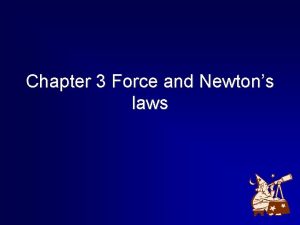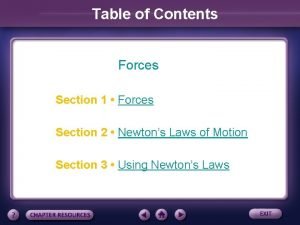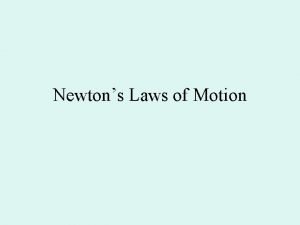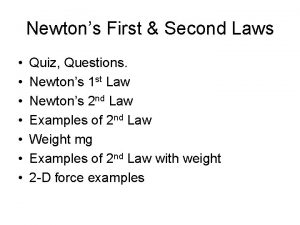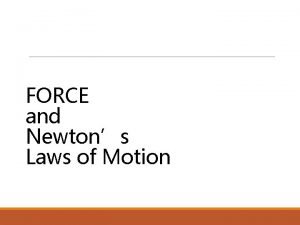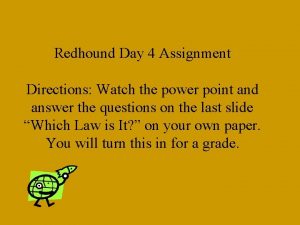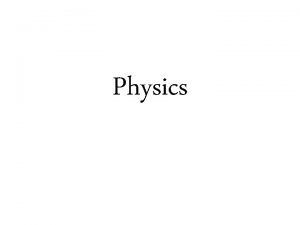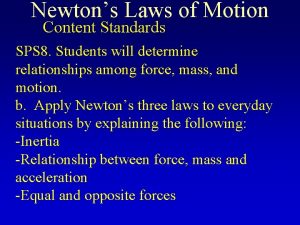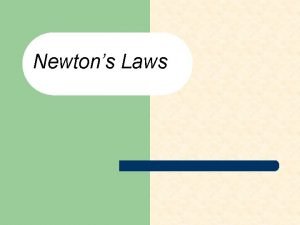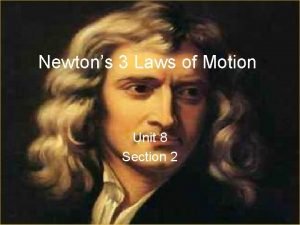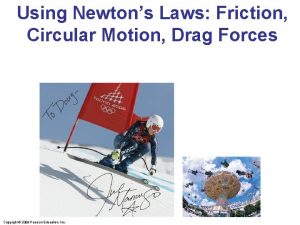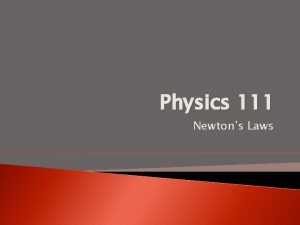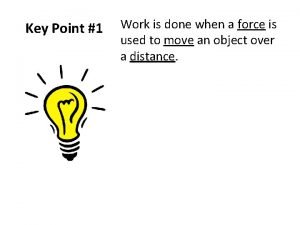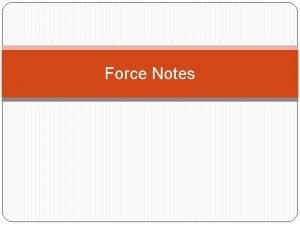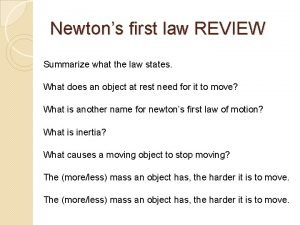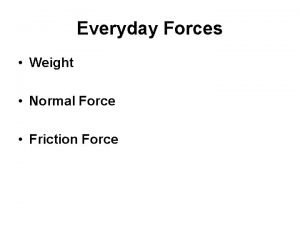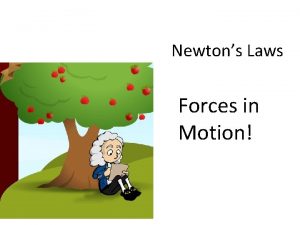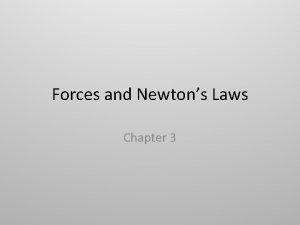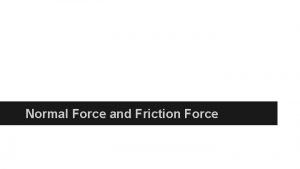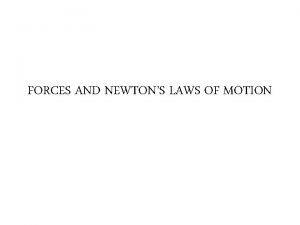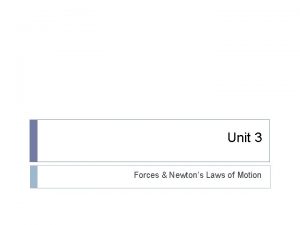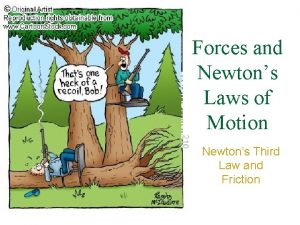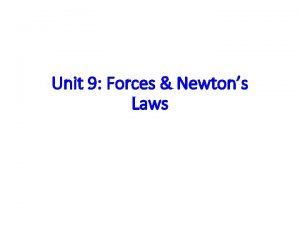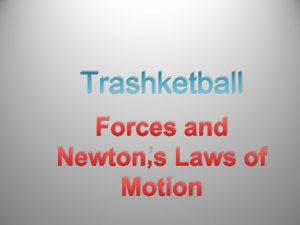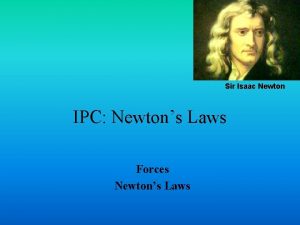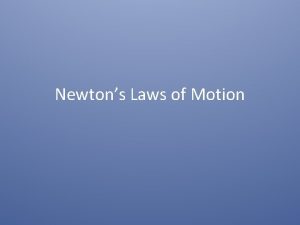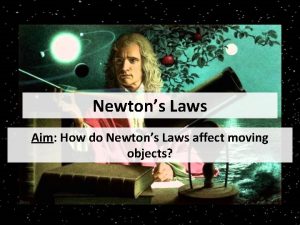Everyday Forces Applications of Newtons Laws Normal force



























- Slides: 27

Everyday Forces Applications of Newton’s Laws

Normal force l l l The normal force is a force that keeps one object from penetrating into another object. The normal force is always perpendicular a surface. The normal exactly cancels out the components of all applied forces that are perpendicular to a surface.

Normal force on flat surface l l The normal force is equal to the weight of an object for objects resting on horizontal surfaces. N = W = mg N mg

…but this is not always the case! For example… -pulling at an angle -objects on inclined surfaces

Normal force not associated with weight. l A normal force can exist that is totally unrelated to the weight of an object. applied force normal friction weight N = applied force

Friction l l Friction is the force that opposes a sliding motion. Friction is due to microscopic irregularities in even the smoothest of surfaces. Friction is highly useful. It enables us to walk and drive a car, among other things. Friction is also dissipative. That means it causes mechanical energy to be converted to heat. We’ll learn more about that later.

Microscopic View N (friction) f W Big view: Surfaces look perfectly smooth. Fpush Small view: Microscopic irregularities resist movement. Friction may or may not exist between two surfaces. The direction of friction, if it exists, is opposite to the direction object will slide when subjected to a horizontal force. It is always parallel to the surface.

Friction depends on the normal force. l l l The friction that exists between two surfaces is directly proportional to the normal force. Increasing the normal force increases friction; decreasing the normal force decreases friction. This has several implications, such as… l l l Friction on a sloping surface is less than friction on a flat surface (since the normal force is less on a slope). Increasing weight of an object increases the friction between the object and the surface it is resting on. Weighting down a car over the drive wheels increases the friction between the drive wheels and the road (which increases the car’s ability to accelerate).

Static Friction l l This type of friction occurs between two surfaces that are not slipping relative to each other. f s s. N l l l fs : static frictional force (N) s: coefficient of static friction N: normal force (N)

fs < ms. N is an inequality! l l The fact that the static friction equation is an inequality has important implications. Static friction between two surfaces is zero unless there is a force trying to make the surfaces slide on one another. Static friction can increase as the force trying to push an object increases until it reaches its maximum allowed value as defined by s. Once the maximum value of static friction has been exceeded by an applied force, the surfaces begin to slide and the friction is no longer static friction.

Static friction and applied horizontal force Force Diagram N Physics W fs = 0 surface There is no static friction since there is no applied horizontal force trying to slide the book on the surface.

Static friction and applied horizontal force Force Diagram N fs Physics W 0 < fs < s. N and fs = F F surface Static friction is equal to the applied horizontal force, and there is no movement of the book since SF = 0.

Static friction and applied horizontal force Force Diagram N fs Physics W fs = s. N and fs = F F surface Static friction is at its maximum value! It is still equal to F, but if F increases any more, the book will slide.

Static friction and applied horizontal force Force Diagram N fk Physics W fs = s. N and fs < F F surface Static friction cannot increase any more! The book accelerates to the right. Friction becomes kinetic friction, which is usually a smaller force.

Kinetic Friction l l This type of friction occurs between surfaces that are slipping past each other. fk = k. N l l fk : kinetic frictional force (N) k: coefficient of kinetic friction N: normal force (N) Kinetic friction (sliding friction) is generally less than static friction (motionless friction) for most surfaces.

Sample Problem A 10 -kg box rests on a ramp that is laying flat. The coefficient of static friction is 0. 50, and the coefficient of kinetic friction is 0. 30. a) What is the maximum horizontal force that can be applied to the box before it begins to slide? b) What force is necessary to keep the box sliding at constant velocity?


Sample Problem A 10 -kg wooden box rests on a ramp that is lying flat. The coefficient of static friction is 0. 50, and the coefficient of kinetic friction is 0. 30. What is the friction force between the box and ramp if a) no force horizontal force is applied to the box? b) a 20 N horizontal force is applied to the box? c) a 60 N horizontal force is applied to the box?


Tension l l l Tension is a pulling force. Tension arises when a rope, string, or other long thin material resists being pulled apart without stretching significantly. Tension always pulls away from a body attached to a rope or string and toward the center of the rope or string.

A physical picture of tension Imagine tension to be the internal force preventing a rope or string from being pulled apart. Tension as such arises from the center of the rope or string. It creates an equal and opposite force on objects attached to opposite ends of the rope or string.

Tension examples Note that the pulleys shown are magic! They affect the tension in any way, and serve only to bend the line of action of the force.

Connected objects l l l Objects connected to each other accelerate at the same rate. Force is transmitted from one object to the next in proportion to the mass of each object. Tension is often a part of such a situation.

Sample problem A. B. A 1, 500 kg crate hangs motionless from a crane cable. What is the tension in the cable? Ignore the mass of the cable. Suppose the crane accelerates the crate upward at 1. 2 m/s 2. What is the tension in the cable now?


Sample problem A 5. 0 kg object (m 1) is connected to a 10. 0 kg object (m 2) by a string. If a pulling force F of 20 N is applied to the 5. 0 kg object as shown, A) what is the acceleration of the system? B) what is the tension in the string connecting the objects? (Assume a frictionless surface. )

 What are the laws of motion
What are the laws of motion تسارع الجاذبية
تسارع الجاذبية What are newton's 3 laws
What are newton's 3 laws Newtons laws of gravity
Newtons laws of gravity Section 3 using newtons laws
Section 3 using newtons laws Section 3 using newtons laws
Section 3 using newtons laws Abcd8n
Abcd8n Colin skateboards down the sidewalk
Colin skateboards down the sidewalk Newtons 1 st law
Newtons 1 st law Newtons first lw
Newtons first lw Newtons 3 laws quiz
Newtons 3 laws quiz Newtons laws definitions
Newtons laws definitions Newtons 3 laws
Newtons 3 laws Newton law
Newton law Newtons 3 laws of motion
Newtons 3 laws of motion What are newton's laws
What are newton's laws What are newton's three laws
What are newton's three laws What is newton's 3 law of motion
What is newton's 3 law of motion Second law of motion examples
Second law of motion examples Newton's three law
Newton's three law Newton's laws of motion
Newton's laws of motion Newtons laws
Newtons laws An african elephant can reach heights of 13 feet
An african elephant can reach heights of 13 feet Hooke's law vector form
Hooke's law vector form Shear and moment diagram examples
Shear and moment diagram examples Tommy does 15 joules of work
Tommy does 15 joules of work A force of 25 newtons east
A force of 25 newtons east First law review
First law review




